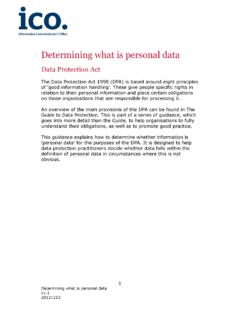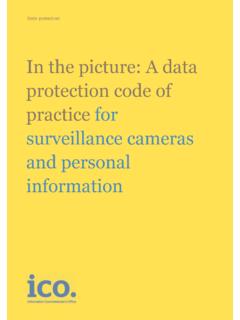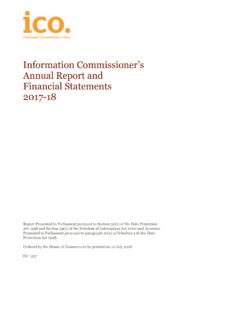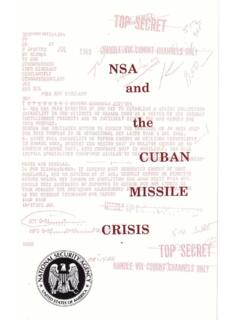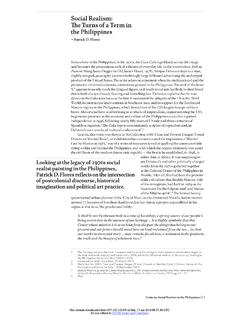Transcription of Anonymisation: managing data protection risk code of practice
1 Data protectionAnonymisation: managing data protection risk code of practice2 xxContents 3 Information Commissioner s foreword 41. About this code 62. anonymisation and personal data 113. Ensuring anonymisation is effective 184. Do you need consent to produce or disclose anonymised data? 285. Personal data and spatial information 306. Withholding anonymised data 347. Different forms of disclosure 368. Governance 399. The Data protection Act research exemption 44 Appendix 1 Glossary 48 Appendix 2 Some key anonymisation techniques 51 Appendix 3 Further reading and sources of advice 54 Annex 1 Converting personal data into anonymised data 57 Annex 2 anonymisation case-studies 66 Annex 3 Practical examples of some anonymisation techniques 80 Contents4 Information Commissioner s forewordThe UK is putting more and more data into the public domain.
2 The government s open data agenda allows us to find out more than ever about the performance of public bodies. We can piece together a picture that gives us a far better understanding of how our society operates and how things could be improved. However, there is also a risk that we will be able to piece together a picture of individuals private lives too. With ever increasing amounts of personal information in the public domain, it is important that organisations have a structured and methodical approach to assessing the risks. This code of practice is about managing that risk. My office has seen the risks both understated and office has been a strong supporter of the open data agenda, and has played its part in ensuring that all sorts of valuable data has been made available through the Freedom of Information Act 2000. One thing that has become clear, however, from my office s experience of dealing with information rights is that issues surrounding the release of information about individuals can be the hardest to deal with in practice .
3 Finding out about the performance of a public authority, for example, inevitably involves finding out about the performance of its staff. We want openness, but we want privacy too. That is why the subject matter of this code of practice anonymisation is so important. If we assess the risks properly and deploy it in the right circumstances, anonymisation can allow us to make information derived from personal data available in a form that is rich and usable, whilst protecting individual data subjects. The current Data protection Directive, dating from 1995, says that the principles of data protection shall not apply to data rendered anonymous in such a way that the data subject is no longer identifiable. It also says that a code of practice can provide guidance as to the ways in which data may be rendered anonymous and retained in a form in which identification of the data subject is no longer possible.
4 Yet, as far as I am aware, this is the first code of practice on anonymisation to be published by any European data protection authority. Issues surrounding anonymisation techniques and the status of anonymised data are becoming a key issue as discussion of the European Commission s proposal for a new data protection framework continues. Information Commissioner s foreword Information Commissioner s foreword 5 This code of practice is not a security engineering manual, nor does it cover every anonymisation technique. The anonymisation Network will provide greater access to more detailed expertise and advice. But it does contain clear, practical advice and a straightforward explanation of some very tricky legal concepts. This code of practice will be of use to freedom of information and data protection practitioners, and to all those who are contributing to the creation of one of the world s most transparent and accountable economies.
5 Christopher Graham Information Commissioner6 About this code Key points : Data protection law does not apply to data rendered anonymous in such a way that the data subject is no longer identifiable. Fewer legal restrictions apply to anonymised data. The anonymisation of personal data is possible and can help service society s information needs in a privacy-friendly way. The code will help all organisations that need to anonymise personal data, for whatever purpose. The code will help you to identify the issues you need to consider to ensure the anonymisation of personal data is effective. The code focuses on the legal tests required in the Data protection code explains the issues surrounding the anonymisation of personal data, and the disclosure of data once it has been anonymised. It explains the relevant legal concepts and tests in the Data protection Act 1998 (DPA).
6 The code provides good practice advice that will be relevant to all organisations that need to convert personal data into a form in which individuals are no longer identifiable. We use the term anonymised data to refer to data that does not itself identify any individual and that is unlikely to allow any individual to be identified through its combination with other data. The DPA does not require anonymisation to be completely risk free you must be able to mitigate the risk of identification until it is remote. If the risk of identification is reasonably likely the information should be regarded as personal data - these tests have been confirmed in binding case law from the High Court. Clearly, 100% anonymisation is the most desirable position, and in some cases this is possible, but it is not the test the DPA use the term re-identification to describe the process of turning anonymised data back into personal data through the use of data matching or similar techniques.
7 The code s annexes contain examples of various anonymisation and re-identification techniques and illustrations of how anonymised data can be used for various purposes. See Annex 1, which shows how a set of personal data can be converted into various forms of anonymised data. About this code1 About this code 7We use the broad term anonymisation to cover various techniques that can be used to convert personal data into anonymised data. We draw a distinction between anonymisation techniques used to produce aggregated information, for example, and those such as pseudonymisation that produce anonymised data but on an individual-level basis. The latter can present a greater privacy risk, but not necessarily an insurmountable one. We also draw a distinction between publication to the world at large and the disclosure on a more limited basis for example to a particular research establishment with conditions attached.
8 See case study 1: limited access to pharmaceutical data. The code shows that the effective anonymisation of personal data is possible, desirable and can help society to make rich data resources available whilst protecting individuals privacy. anonymisation is of particular relevance at the moment, given the increased amount of information being made publicly available through Open Data initiatives and through individuals posting their own personal data online. The code supports the Information Commissioner s view that the DPA should not prevent the anonymisation of personal data, given that anonymisation safeguards individuals privacy and is a practical example of the privacy by design principles that data protection law promotes. We hope that the code shows that, in some circumstances, anonymisation need not be an onerous process. In some cases really quite simple techniques can be very effective.
9 See case study 2, using mobile phone data to study road traffic speeds and case study 3, which demonstrates a simple technique for anonymising data about passengers travelling information, particularly datasets containing sensitive personal data, will clearly present a need for caution, and the anonymisation issues may be complex for large datasets containing a wide range of personal data. It is in these complex scenarios in particular that organisations should consider whether they need specialist expertise and code was written for a general readership and only looks at the issue of anonymisation in the context of the DPA and Freedom of Information Act 2000 (FOIA). It does not go into all the other legal issues that could be relevant. We have tried to make the code as consistent as possible with other authoritative guidance. However, the Information Commissioner recognises that organisations may also need to follow their own detailed standards and procedures, tailored to the data they hold and its intended code cannot describe every anonymisation technique that has been developed nor go into a great deal of technical detail.
10 Additional information is available from the sources we have listed and will be developed through the Information Commissioner s anonymisation Network. The Network will also host detailed case studies and illustrations of good practice . The network will be launched at the same time as this code of practice ; details will be available on the ICO website. Many important issues concerning anonymisation have arisen in the context of the FOIA and the Freedom of Information (Scotland) Act 2002 (FOISA). We are confident that this code will help public authorities in Scotland and the rest of the UK to deal with cases where personal data must be withheld, but anonymised data can be released. References to FOIA can be read across to include FOISA as well. Who is this code of practice for?Any organisation that needs or wants to turn personal data into anonymised data should use this code.
